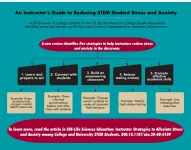INFORMATION:
Study of severe pediatric COVID-19 syndrome highlights differences in immune responses to SARS-CoV-2
2021-03-02
(Press-News.org) A new study of patients with Multisystem Inflammatory Syndrome in Children (MIS-C), a rare but severe complication of COVID-19 in children, reveals distinct immune features of COVID-19 not seen in adults that may clue scientists in to why SARS-CoV-2 infection manifests differently in children compared with adults. Their results showed that although the immune landscape in pediatric COVID-19 was similar to that in adults, MIS-C patients uniquely exhibited increased activation of a blood vessel-patrolling CD8+ killer T cell subset, and all pediatric COVID-19 patients harbored greater B cell frequencies for a more prolonged period of time than observed in healthy adults. MIS-C is characterized by pervasive inflammation, an array of symptoms ranging from fever to vomiting, and insufficient blood flow throughout the body that can lead to shock. To home into the immune features of MIS-C, Laura Vella and colleagues analyzed immune responses in blood taken from 30 hospitalized SARS-CoV-2-infected pediatric patients - 14 of whom were diagnosed with MIS-C. They compared results of this analysis with samples from adult COVID-19 patients, recovered adult COVID-19 subjects, and healthy adults. While MIS-C patients exhibited patterns of decreasing T cell count and activation similar to adults with severe COVID-19, they also exhibited robust activation of a killer T cell subset that patrols and interacts with the vasculature to control viral persistence. This feature was not observed in either adult or non-MIS-C pediatric COVID-19 patients. In addition, while children with COVID-19-driven acute respiratory distress syndrome had sustained immune activation, overall immune activation in MIS-C patients decreased over time, paralleling clinical improvement. All pediatric COVID-19 patients had substantially elevated B cell frequencies compared to healthy adults, but future work will be necessary to dissect how this impacts disease. Together, these findings portray the variability in immune responses to SARS-CoV-2 across ages and patient populations and may help inform treatments for severe COVID-19 in children.
ELSE PRESS RELEASES FROM THIS DATE:
An instructor's guide to reducing college students' stress and anxiety
2021-03-02
Orange, Calif. - Even before the COVID-19 pandemic, college students were reporting record levels of stress and anxiety. According to the American College Health Association END ...
Deepwater Horizon's long-lasting legacy for dolphins
2021-03-02
The Deepwater Horizon disaster began on April 20, 2010 with an explosion on a BP-operated oil drilling rig in the Gulf of Mexico that killed 11 workers. Almost immediately, oil began spilling into the waters of the gulf, an environmental calamity that took months to bring under control, but not before it became the largest oil spill in the history of the petroleum industry.
Nearly 10 years have passed since then, and the oil slick has long since dispersed. Yet, despite early predictions, area wildlife are still feeling the effects of that oil, and research published in Environmental Toxicology and Chemistry has shown that negative health impacts have befallen not only dolphins alive at the time of the spill, but also in their young, born years later.
A team of researchers, including ...
Yale team finds dozens of genes that block regeneration of neurons
2021-03-02
When central nervous system cells in the brain and spine are damaged by disease or injury, they fail to regenerate, limiting the body's ability to recover. In contrast, peripheral nerve cells that serve most other areas of the body are more able to regenerate. Scientists for decades have searched for molecular clues as to why axons -- the threadlike projections which allow communication between central nervous system cells -- cannot repair themselves after stroke, spinal cord damage, or traumatic brain injuries.
In a massive screen of 400 mouse genes, Yale School of Medicine ...
Disruption of lung biological clock in premature babies may raise later flu risk
2021-03-02
Disruptions in the circadian rhythms in lung cells may explain why adults who survived premature birth are often more at risk of severe influenza infections, suggests a study in mice published today in eLife.
Dramatic improvements in the care of infants born prematurely have allowed many more to survive into adulthood. Yet ex-preemies can face several long-term side effects of the life-saving care they received. The study suggests potential new approaches to treating lasting lung problems in those born prematurely.
Many premature infants are not able to breathe on their own and require oxygen to survive. ...
Study: Using a warmer tone in college syllabi makes students more likely to ask for help
2021-03-02
College course syllabi written in a warm, friendly tone are more likely to encourage students to reach out when they are struggling or need help, a new study from Oregon State University found.
Conversely, when a syllabus is written in a more cold, detached tone, students are less likely to reach out.
The study also compared the effect of syllabus tone with the effect of a deliberate "Reach out for help" statement included in the document.
"The instructor has to ask themselves, what's the first point of contact with the class for the student? In an online class and in remote learning, the syllabus is often the ...
Rating tornado warnings charts a path to improve forecasts
2021-03-02
The United States experiences more tornadoes than any other country, with a season that peaks in spring or summer depending on the region. Tornadoes are often deadly, especially in places where buildings can't withstand high winds.
Accurate advanced warnings can save lives. A study from the University of Washington and the National Oceanic and Atmospheric Administration describes a new way to rate and possibly improve tornado warnings. It finds that nighttime twisters, summer tornadoes and smaller events remain the biggest challenges for the forecasting community.
"This new method lets us measure how forecast skill is improving, decreasing or staying the same in different situations," said Alex ...
Study highlights pitfalls associated with 'cybervetting' job candidates
2021-03-02
A recent study of how human resources professionals review online information and social media profiles of job candidates highlights the ways in which so-called "cybervetting" can introduce bias and moral judgment into the hiring process.
"The study drives home that cybervetting is ultimately assessing each job candidate's moral character," says Steve McDonald, corresponding author of the study and a professor of sociology at North Carolina State University. "It is equally clear that many of the things hiring professionals are looking at make it more likely for ...
New Geology articles published online ahead of print in February
2021-03-02
p>
Boulder, Colo., USA: Several new articles were published online ahead of
print for Geology in February. Topics include stress in survivor
plants following the collapse of land ecosystems, the Gulf of Aden, whether
the Denali fault is still active, the first reported Burgess Shale-type
fauna rediscovered, and redefining the age of the lower Colorado River.
These Geology articles are online at END ...
A Skoltech robot analyzes shoppers' behavior
2021-03-02
Researchers from Skoltech's Intelligent Space Robotics Lab have proposed a novel method for customer behavior analytics and demand distribution based on Radio Frequency Identification (RFID) stocktaking. Their research was published in the proceedings of the International Conference on Control, Automation, Robotics and Vision (ICARCV).
Autonomous robotic systems that already pervade our daily lives are faced with a host of challenging tasks, such as stocktaking in a rapidly changing environment.
A Skoltech team led by Professor Dzmitry Tsetserukou from the Skoltech Space Center (Intelligent Space Robotics Lab) has proposed a novel method that helps ...
Oregon researchers unveil the weaving fractal network of connecting neurons
2021-03-02
EUGENE, Ore. - March 2, 2021 - High-resolution imaging and 3D computer modeling show that the dendrites of neurons weave through space in a way that balances their need to connect to other neurons with the costs of doing so.
The discovery, reported in Nature Scientific Reports Jan. 27, emerged as researchers sought to understand the fractal nature of neurons as part of a University of Oregon project to design fractal-shaped electrodes to connect with retinal neurons to address vision loss due to retinal diseases.
"The challenge in our research has been understanding how the neurons we want to target in the retina will connect to our electrodes," said Richard Taylor, a professor and head ...



